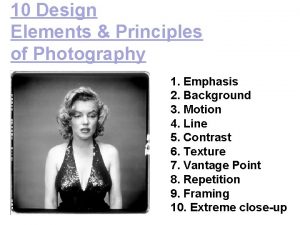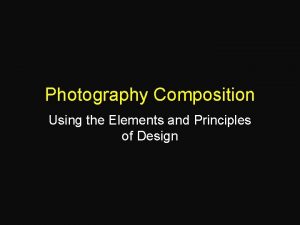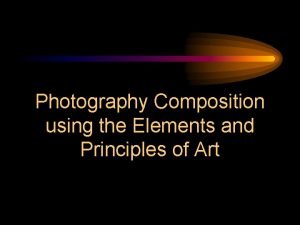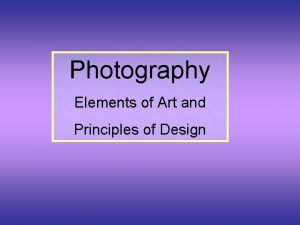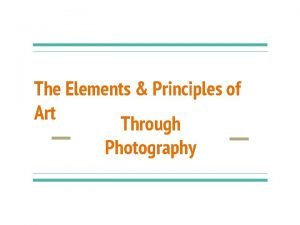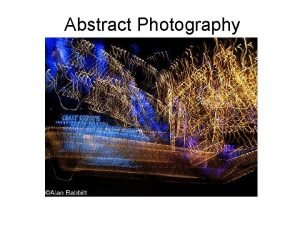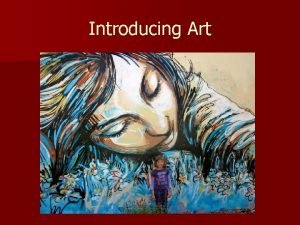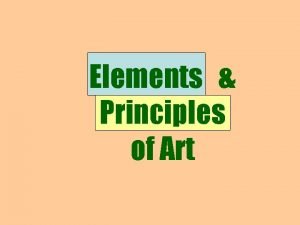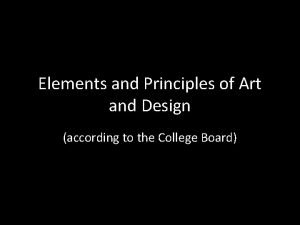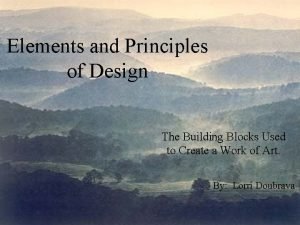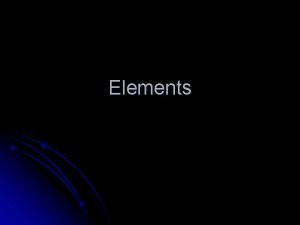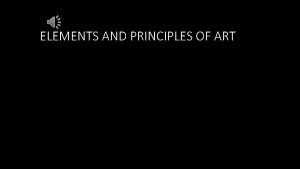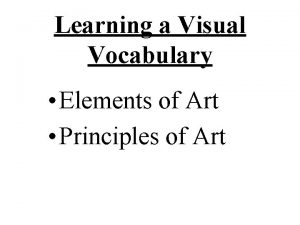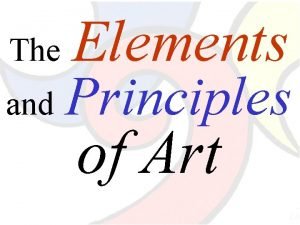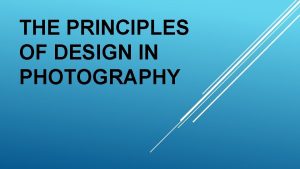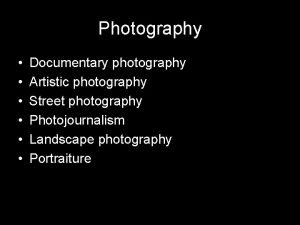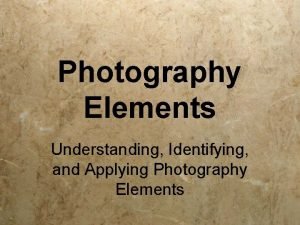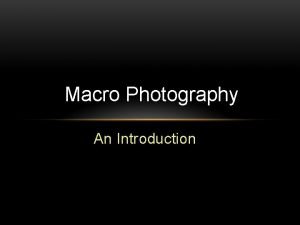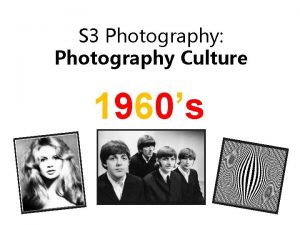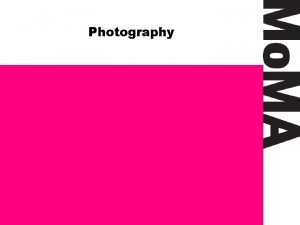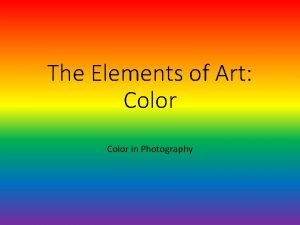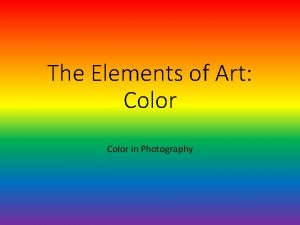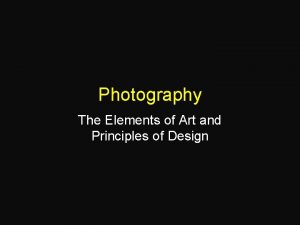The Elements Principles of Art Through Photography The


















- Slides: 18

The Elements & Principles of Art Through Photography

The Language of Art ● ● ● Art is a form of nonverbal communication. Communicating ideas drives our human connections. Each art form has a distinct set of words that related to their artistic practice. Having a common language when speaking of art is key to successful communication both from an artist perspective and as well as that of the viewer. The Elements and Principles of Art can be considered a foundation from which we can speak in general terms regarding all art forms.

Elements of Art ● ● ● The elements of art are the “building block” of design. All good design will have one or more of these elements; ○ line, color, shape, form, texture, space, and value. The following presentation will show images that contain the elements of art within the medium of photography. Other art methods, such as animation, painting, fashion, and sculpture also incorporate the elements of art.

Line ● A line is one-dimensional make made by a moving point. ● It can vary in width, direction, and length. ● Lines can be obvious or subtle and define the edges of a form. ● Lines can be horizontal, vertical, or diagonal, straight or curved, zig -zag, thick, thin, etc. . ● Lines lead your eye around the composition. ● In photography we say, “lines that lead the eye”. Alfred Steiglitz, The Steerage, 1907

Color ● Colors affect how we see the world and read it. ● We need light to see color. ● The artistic term for color is HUE. ● The intensityof a HUE refers to how bright or dull it is. ● Colors can also be described as warm (red, yellow), or cool (blue, green). ● Monochromatic-one color plus its tints (adding white) and shades (adding black). ● Complimentary Colorscolors opposite each other on the color wheel. (ex. Green & Red). Sandy Skoglund, Revenge of the Goldfish, 1981

Shape ● Shape is a contained area used to create a sense of space. ● Shape is 2 -dimensional, with a height and width. ● Organic Shape: a shape made by nature such as an apple, plant, human, etc. ● Inorganic Shape: manmade- such as triangles, square, rectangle, etc. . Laszlo Moholy-Nagy, Photogram,

Form ● Forms are 3 dimensional, has height, width, and depth. ○ Sphere ● Photographers emphasize form in 2 dimensional images by using highlights and shadows. Ansel Adams, Mount Williamson- Clearing Storm, 1944

Texture ● Texture is the surface quality of an object. ● All objects have a physical texture (rough, smooth, sharp, hard, etc. ) ● We sense through touch and use our memory to recall how an object may feel. Texture may evoke an emotional response and adds interest to an image. ● In a two dimensional work, texture gives a visual sense of how an object depicted would feel in real life if touched. Kelly Clark, Tiger Cat!,

Space ● ● ● ● Real space is three dimensional. Space in a work of art refers to a feeling of depth and dimension. It can also refer to an artist’s use of the area around the picture plane. Positive Space- The space occupied by the primary object or subject. Negative Space-The space around the primary object or subject. Foreground (closest area), Middle Ground, Background (farthest) Josef Koudelka, Czechoslovakia, 1968

Value ● Value refers to the lightness or darkness of a surface. ● Value is frequently used when talking about shading, but is also important in the study of color. ● Value gives the viewer a sense of drama, impact, timelessness. Edward Weston, Pepper, 1930

Principles of Art ● ● ● The principles of art are the rules or guidelines of art. Used to organize or arrange the structural elements of design. Principles are balance, proportion, rhythm, emphasis, harmony, varietyand unity.

Balance is similar to our physical sense of balance. It is how the artist uses opposing forces in a composition that results in visual stability. Most successful compositions achieve balance in one of two ways: symmetrically (the same on both sides, like a butterfly wing) or asymmetrically. Annie

Proportion relates to the relative size and scale of the various elements in a design. Specifically, the relationship between the objects. Diane Arbus, A Jewish Giant At Home With His Parents in the Bronx, NY, 1970

Rhythm in an artwork indicates movement by the repetition of elements. Rhythm can make an artwork seem active. Robert Capa, D-Day Landing, 1944

Emphasis is to make one part of an artwork dominant over the other parts. It attracts the viewer’s eyes to a place of special importance in an artwork. Steve Mc. Curry, Afghan Girl,

Harmony is the pleasing quality achieved by different elements of a composition interacting to form a whole. Harmony is often accomplished through repetition of the same or similar characteristics. Joel Meyerowitz, Cape Light,

Variety Differences achieved by opposing, contrasting, changing, elaborating, or diversifying elements in a composition to add individualism and interest. Robert Frank, Rodeo, New York City,

Unity is the result of bringing the elements of art into the appropriate ratio between harmony and variety to achieve a sense of oneness. It is the sense that everything works together and looks like it fits. Mary Ellen Mark, Monkey Trainer’s Daughter: Indian Street Performers, New Delhi, India, 1980
 Elements and principles of photography
Elements and principles of photography Principles of photography
Principles of photography Photography principles
Photography principles Photography elements and principles of design
Photography elements and principles of design Elements of art: color
Elements of art: color Elements of art photography
Elements of art photography Is abstract photography same as conceptual photography
Is abstract photography same as conceptual photography The actual surface feel of the simulated appearance
The actual surface feel of the simulated appearance Elements principles of art
Elements principles of art A feeling of visual equality in shape form value color
A feeling of visual equality in shape form value color Elements and principles of art
Elements and principles of art Elements and principles of art
Elements and principles of art Value rhythm art
Value rhythm art Line shape form color texture space
Line shape form color texture space Basic elements of music play theater
Basic elements of music play theater Principles of art
Principles of art Art vocabulary elements and principles
Art vocabulary elements and principles Principles of art
Principles of art Is a consistent, orderly or pleasing arrangement of parts.
Is a consistent, orderly or pleasing arrangement of parts.
